Dear Readers, Take Free Reasoning Ability Sectional Test of 35 Questions as like in the real exam to analyze your preparation level. Our Sectional Test Questions are taken as per the latest exam pattern and so it will be really useful for you to crack the prelims exam lucratively. Students who are weak in Reasoning Ability should utilize this chance constructively to accomplish a successful profession in Banking Field.
[WpProQuiz 4462]Click Here for IBPS Clerk Prelims 2018 High-Quality Mocks
Direction (1-5): Study following information carefully and answer the questions given below.
Eight friends – A, B, C, D, E, F, G and H are going to Delhi on two different dates 11 and 18 of four different months, viz. January, April, May and June. Only one person goes to Delhi on one date of one month.
C goes before G. Only two persons go in between E and D. H goes on an even date of the month but not June 18. The number person goes before B is same as the number of persons goes after D. Only one person goes in between H and B. Only one person goes in between C and G. The number of persons goes in between F and D is same as A and H. B goes before H.
1) How many person goes in between C and E?
a) Four
b) Five
c) Six
d) Three
e) None of these
2) Which of the following combinations is correct?
a) June 18- E
b) April 18- H
c) June 11- D
d) January 18- B
e) None of these
3) Four of the following five are alike in certain way and thus form a group as per the given arrangement. Which of the following does not belong to that group?
a) H
b) E
c) B
d) A
e) G
4) Who among the following goes to Delhi in June 18?
a) F
b) E
c) A
d) C
e) None of these
5) F is related to H in a certain way based on the given arrangement. In the same way E is related to C. Which of the following persons is B related to following the same pattern?
a) D
b) H
c) A
d) G
e) None of these
Direction (6-8): Read the given information carefully answer the questions given below.
The Given Answers;
a) Only Conclusion I follows
b) Only Conclusion II follows
c) Either Conclusion I or Conclusion II follows
d) Both Conclusion I and Conclusion II follows
e) Neither Conclusion I nor Conclusion II follows
6)
Statement:
No Blue are Green
All Green are Grey
No Grey are Brown
Conclusion:
I). All Blue being Grey are Possible
II). No Green are Brown
7)
Statement:
All Fan are Light
Some Light are Cooler
Some Cooler are LED
Conclusion:
I). All LED are Fan
II). Some Fan are LED
8)
Statement:
Some Shudi are Salwar
No Salwar are Jean
Some Jean are Shawl
Conclusion:
I). Some Shawl are not Salwar
II). No Shudi are Jean
Direction (9-11): Each of the questions below consists of a question and two statements numbered I and II given below it. You have to decide whether the data provided in the statements are sufficient to answer the question. Read both the statements and give answer
a) If the data in statement I alone are sufficient to answer the question, while the data in statement II alone are not sufficient to answer the question.
b) If the data in statement II alone are sufficient to answer the question, while the data in statement I alone are not sufficient to answer the question.
c) If the data either in statement I alone or in statement II alone are sufficient to answer the question.
d) If the data in both statement I and II together are not sufficient to answer the question.
e) If the data in both statement I and II together are necessary to answer the question.
9) If the week days starting from Monday to Sunday. On which day does Raghul took leave?
Statement I: Kavitha said, Raghul was present on Monday and Wednesday. Kajal said, Ragul does not took leave on any of the days after Wednesday.
Statement II: Samir said that, Raghul does not took leave any of the days after Tuesday. Ragul was not leave on first day of the week.
10) Amir, Bala, Charan, Dhiva, Eswar and Fazil are the six people in the group. Who among the following person got highest score?
Statement I: Fazil scored more than Charan, who scored less than Eshwar. Amir scored less than Bala.
Statement II: Only two people scored more than Dhiva. Dhiva scored less than Amir, who scored less than Bala.
11) On Which direction does A stands with respect to B?
Statement I: A stands 3 meters north of C, who stands 2 meters west of D. H stands 3 meters south of D. B stands 3 meters west of N. N stands 2 meters south of D.
Statement II: N stands 2 meters north of G, who stands 1 meter west of A. K stands 3 meters north of B.
12) How many such pairs are there in the word “PHOTOGRAPHY” each of which has as many letters between them, in the word as per English alphabet order, When calculated in both forward direction and backward direction?
a) One
b) Two
c) Three
d) More than three
e) None
Direction (13-16): Study the following arrangement carefully and answer the questions given below.
TNE RTA WRS MXC RPU CSO
13) If all the letters in the word are arranged in alphabetical order from left to right, then which of the following word will remains unchanged?
a) WRS
b) RPU
c) CSO
d) TNE
e) None of these
14) If all the letters in the words are arranged in alphabetical order from right to left then, in how many words does the last letter of the word remains unchanged in new arrangement?
a) One
b) Two
c) Three
d) More than Three
e) None
15) In the given arrangement, if the letter is a consonant then the letter should be changed to previous letter of the alphabet and if the letter is a vowel then the letter should be changed to next letter of the alphabet, then how many words are framed with minimum one vowel?
a) One
b) Two
c) Three
d) More than Three
e) None
16) If all the words are arranged in alphabetical order from left to right, then which of the following word will fourth from the right end?
a) WRS
b) RPU
c) CSO
d) TNE
e) None of these
Direction (17-21): Study following information carefully and answer the questions given below.
Eight friends –A, B, C, D, E, F, G and H are sitting in a straight line. Some of them are facing north and some are facing south.
C sits to the immediate right of H. A is faces south. Immediate neighbours of D faces same directions. C sits second to the left of F. E sits third to the right of A. Neither E nor A is an immediate neighbour of C. G sits third to the right of C. E sits second to the right of B. The persons who sit at the extreme ends of the line face the opposite direction. F sits third to the right of D.
17) How many persons sit between C and B?
a) Three
b) Two
c) Four
d) Five
e) None of these
18) Who among the following sit at the extreme ends of the line?
a) E, C
b) A, H
c) B, F
d) G, E
e) None of these
19) How many persons are facing north direction?
a) One
b) Three
c) Four
d) Cannot be determine
e) None of these
20) What is the position of A with respect to G?
a) Immediate right
b) Second to the left
c) Fourth to the right
d) Cannot be determine
e) None of these
21) Who among the following are the immediate neighbours of B?
a) A, D
b) D, G
c) F, H
d) A, C
e) None of these
22) Which of the following conclusion is definitely true according to the statement
A > F ≥ H = E > J < P < O; J > M = N > B ≥ V
a) V = A
b) A = O
c) O < H
d) A > N
e) M ≤ P
23) Which of the following symbol will be possible to make the A > G is false and
R < P is true?
Statement: G = D __ R < W ≤ U __ P = Q < A
a) >, >
b) <, ≤
c) <, >
d) >, <
e) =, =
Direction (24 – 26): Read the following information carefully and answer the questions given below.
A stands 3m north of B, who stands 2m west of C. D stands 1m west of E. F stands 3m south of E. G stands 3m west of F. C stands 2m south of D.
24) In which direction does A stands with respect to E?
a) North West
b) South West
c) North East
d) South West
e) None of these
25) What is the distance between A and G?
a) 3m
b) 4m
c) 5m
d) 6m
e) Cannot be determined
26) What is the shortest distance between A and F?
a) 3m
b) 4m
c) 5m
d) 6m
e) Cannot be determined
27) If all the numbers are arranged in ascending order ‘256721621431’ from left to right, then how many numbers will remains in original position?
a) One
b) Two
c) Three
d) More than three
e) None
Direction (28-32): Study following information carefully and answer the questions given below.
Seven seminars- S, T, U, V, W, X and Y are held in seven different days in the same week, starting from Monday and ending on Sunday. Each of them held in different cities, viz. Chennai, Bangalore, Delhi, Mumbai, Hyderabad, Goa and Kolkata, but not necessarily in the same order.
Seminar S is held in Delhi. Seminar U held in either Wednesday or Saturday. Only one seminar held between X and the seminar held in Bangalore. Seminar Y held immediately after V. Seminar T held in neither Friday nor Sunday. Only two seminars held between S and X. Seminar T is held in Mumbai. Only two seminars held between T and the seminar held in Chennai. Seminar W is held in Goa. Only two seminars held between Kolkata and Goa. Only three seminars held between U and S. Seminar T held in one of the days after W.
28) Which of the following combination is false?
a) Y-Bangalore
b) X-Kolkata
c) U-Chennai
d) W-Goa
e) None of these
29) W is related to Wednesday in a certain way based on the given arrangement. In the same way V is related to Sunday. Which of the following days is U related to following the same pattern?
a) Tuesday
b) Friday
c) Thursday
d) Sunday
e) None of these
30) Which of the following seminar is held in Tuesday?
a) S
b) X
c) V
d) U
e) None of these
31) How many seminars held between Y and T?
a) One
b) Two
c) Three
d) Four
e) None of these
32) Which of the following statements is correct?
a) Seminar U held in Hyderabad
b) Seminar Y held in Kolkata
c) Seminar X held in Chennai
d) Seminar V held in Bangalore
e) None of these
Direction (33 – 34): Read the following information carefully and answer the questions given below.
C is father-in-law of D, who is father of F. A is mother of E, who is son of G. B is sister-in-law of G. C is grandfather of F. C has two daughters. Only two married couples are there. F is male. Not more than seven members are there in a family.
33) How is F related to E?
a) Sister
b) Brother
c) Nephew
d) Cousin
e) None of these
34) How is G related to D?
a) Cousin
b) Brother
c) Nephew
d) Father
e) Sister in law’s husband
35) What is the code for the word ‘UMBERLLA’ The vowels should be changed to next letter of the English alphabet. And the Consonant should be changed to previous letter.
a) TYFDQJJB
b) VTDVPJJB
c) VLAFQKKB
d) VLRFQJJB
e) None of these
Answers:
Direction (1-5):
- H goes on an even date of the month but not June 18.
- Only one person goes in between H and B.
- B goes before H.
- The number person goes before B is same as the number of persons goes after D.
- Now we have 2 Cases.
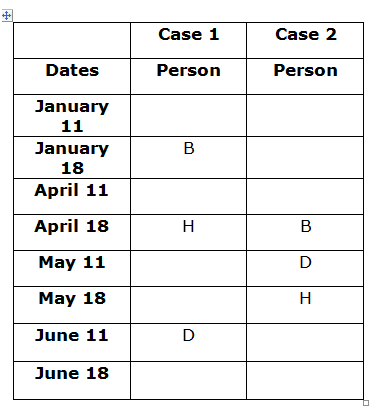
- Only two persons go in between E and D.
- Only one person goes in between C and G.
- C goes before G.
- From the above condition Case 1 was dropped and case 2 derive further 2 Cases.
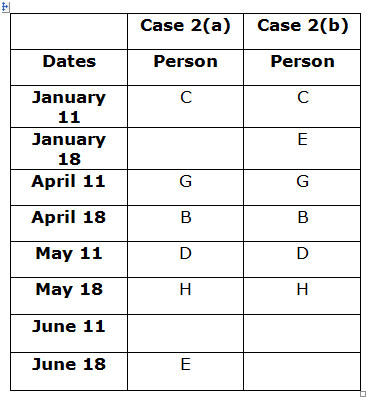
- The number of persons goes in between F and D is same as A and H.
- From the above condition Case 2(a) was dropped.
- So the final arrangement is..
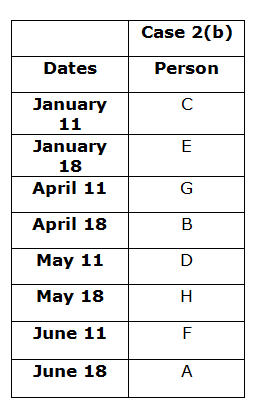
1) Answer: e)
2) Answer: e)
3) Answer: e)
4) Answer: c)
5) Answer: d)
Direction (6-8)
6) Answer: d)
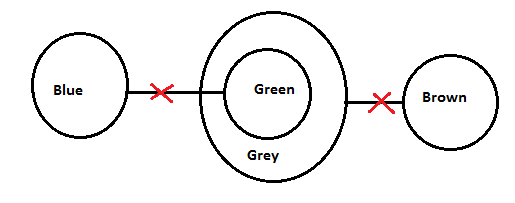
7) Answer: e)
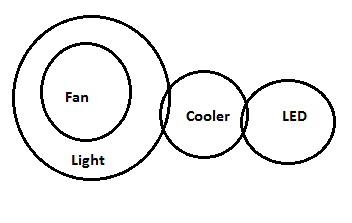
8) Answer: a)
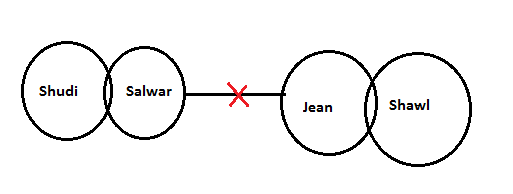
Direction (9-11)
9) Answer: c)
From Statement I –> Raghul was leave on Tuesday
From Statement II –> Raghul was leave on Tuesday, so the data either in statement I alone or in statement II alone are sufficient to answer the question.
10) Answer: b)
From Statement I: Fazil > Charan; Eshwar > Charan; Bala > Amir
From Statement II: Bala > Amir > Dhiva > ___ > ___ > ____
So, the data in statement II alone are sufficient to answer the question, while the data in statement I alone are not sufficient to answer the question.
11) Answer: a)
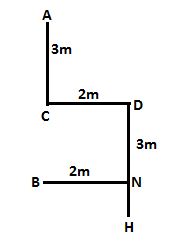
12) Answer: b)
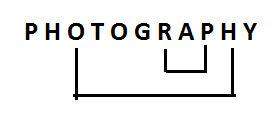
Direction (13-16):
13) Answer: e)
TNE RTA WRS MXC RPU CSO
ENT ART RSW CMX PRU COS
14) Answer: c)
TNE RTA WRS MXC RPU CSO
TNE TRA WSR XMC URP SOC
15) Answer: a)
TNE RTAWRS MXC RPU CSO
SMF QSB VQR LWB QOV BRP
16) Answer: b)
TNE RTA WRS MXC RPU CSO
CSO MXC RPU RTA TNE WRS
Direction (17-21):
- A is faces south.
- E sits third to the right of A.
- Now we have 5 Cases
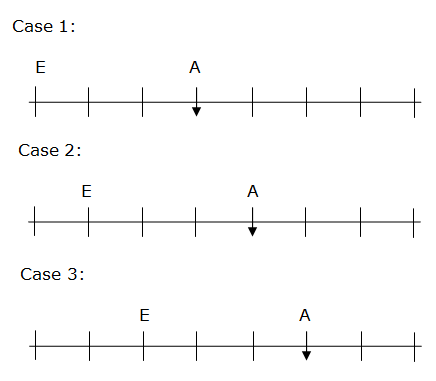
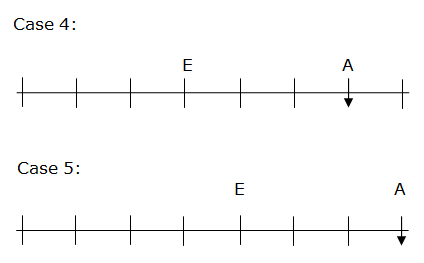
- The persons who sit at the extreme ends of the line face the opposite direction.
- Neither E nor A is an immediate neighbour of C.
- G sits third to the right of C.
- E sits second to the right of B.
- C sits second to the left of F.
- C sits to the immediate right of H.
- From the above condition Case 2, Case 3, Case 4 was dropped.
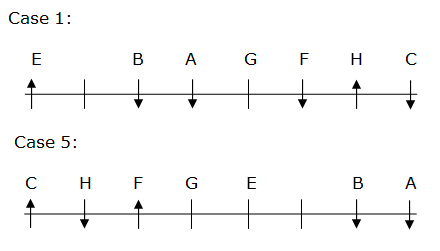
- F sits third to the right of D.
- Immediate neighbours of D faces same directions.
- From the above condition Case 1 was dropped
- So the final arrangement is..

17) Answer: d)
18) Answer: e)
19) Answer: d)
20) Answer: d)
21) Answer: a)
Direction (22-23)
22) Answer: d)
A > F ≥ H = E > J > M = N
23) Answer: d)
Direction (24 – 26):
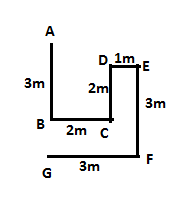
24) Answer: a)
25) Answer: b)
26) Answer: c)
27) Answer: a)
256721621431
111222345667
Direction (28-32):
- Seminar U held in either Wednesday or Saturday.
- Only three seminars held between U and S.
- Only two seminars held between S and X.
- Seminar S is held in Delhi.
- Now we have 2 Cases.
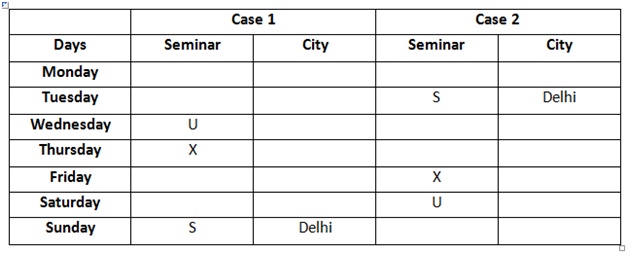
- Seminar Y held immediately after V.
- Seminar T held one of the days after W.
- Seminar T held neither Friday nor Sunday.
- Seminar T is held in Mumbai.
- Only two seminars held between T and seminar held in Chennai.
- From the above condition Case 2 was dropped.
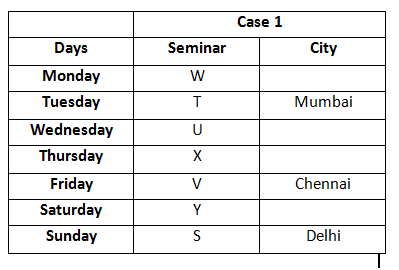
- Only one seminar held between X and the seminar held in Bangalore.
- Seminar W is held in Goa.
- Only two seminars held between Kolkata and Goa.
- So the final arrangement is..
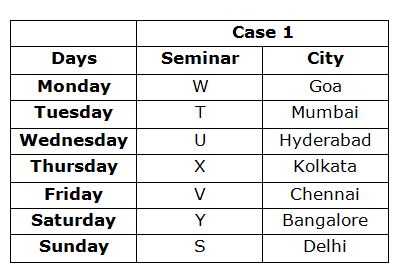
28) Answer: c)
29) Answer: b)
30) Answer: e)
31) Answer: c)
32) Answer: a)
Direction (34-35)
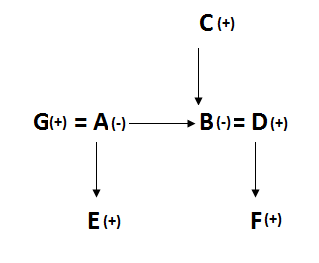
33) Answer: d)
34) Answer: e)
35) Answer: c)
UMBERLLA –> VLAFQKKB





